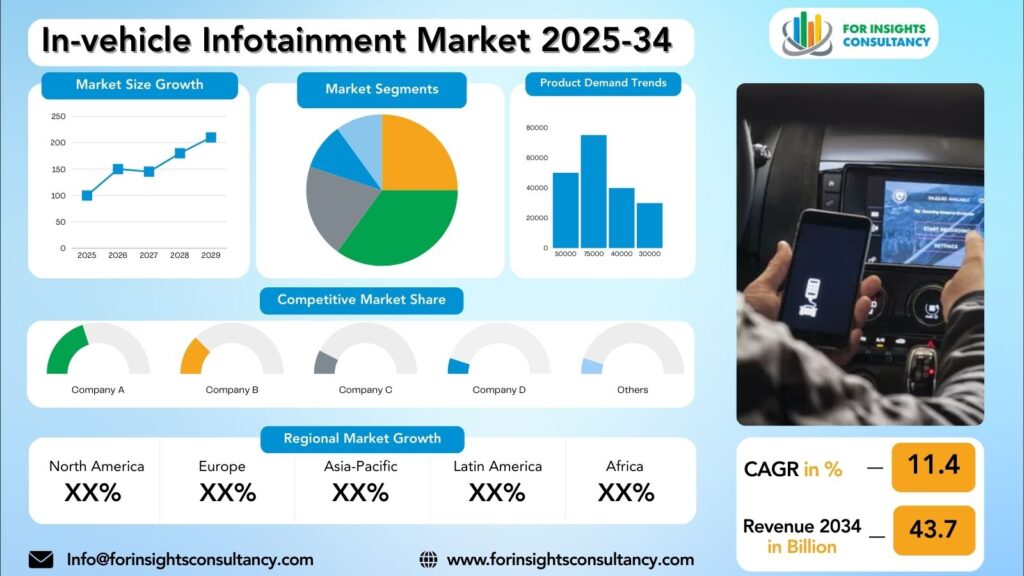
In-vehicle Infotainment Market Size, Trends Analysis Research Report by Operating System (Android, Linux, QNX, Others), by Component (Display Unit, Audio Unit, Navigation Unit, Communication Unit), by Installation Type, by Sales Channel, by Connectivity, and by Region Global Market Analysis and Forecast, 2025-2034
Sep-2025 Formats | PDF | Category: Automotive | Delivery: 24 to 72 Hours
In-vehicle Infotainment Market is forecast to increase from USD 21.3 Billion in 2025 to USD 43.7 Billion by 2034, at a CAGR of 11.4%.
In-vehicle Infotainment Market: A Comprehensive Overview and Future Developments
The in-vehicle infotainment market combines entertainment, communication, and navigation systems in vehicles for a seamless driving experience. Leading manufacturers like BMW, Audi, Mercedes-Benz, and Tesla are leading the way in innovation, offering advanced features like augmented reality navigation and voice-controlled assistants. Other tech companies like Apple and Google are also making significant strides in developing in-vehicle infotainment solutions.
AI and machine learning algorithms are key trends in the market, enabling infotainment systems to learn user preferences and provide personalized recommendations. 5G connectivity is revolutionizing in-vehicle entertainment by enabling high-speed internet access, seamless multimedia streaming, and real-time updates for navigation systems.
The future of the in-vehicle infotainment market is promising, with a focus on connectivity, personalization, and user-friendly interfaces. As autonomous driving technology advances, infotainment systems will play a crucial role in keeping passengers engaged and entertained. The integration of smart home devices and IoT technology will further enhance the overall in-car experience.
In-vehicle Infotainment Market Dynamics
Growth Drivers
The in-vehicle infotainment market is experiencing rapid growth due to the integration of advanced technologies, increasing consumer demand for connectivity, and the rise of electric vehicles and autonomous driving. Modern infotainment systems now offer features such as touch-screen displays, voice recognition, smartphone integration, navigation services, and entertainment options. Consumers are increasingly demanding these capabilities to stay connected while on the road, leading to a surge in demand for in-vehicle infotainment solutions.
Automakers are incorporating enhanced connectivity features into their infotainment systems, driving further adoption of these technologies. Emphasis is being placed on driver safety and convenience, with in-vehicle infotainment systems evolving to offer hands-free operation and voice-controlled functionalities. This not only improves the overall driving experience but also reduces distractions on the road.
The rise of electric vehicles and autonomous driving technologies is also fueling growth in the in-vehicle infotainment market. As automakers transition towards electric and autonomous vehicles, there is a greater focus on developing advanced infotainment systems that cater to their specific needs. In conclusion, the in-vehicle infotainment market is experiencing rapid growth driven by the integration of advanced technologies, increasing consumer demand for connectivity, and the rise of electric vehicles and autonomous driving.
Restraints
In-vehicle infotainment systems have evolved significantly over the years, offering a range of features such as GPS navigation, Bluetooth connectivity, internet browsing, and smartphone integration. The rise of connected cars has further fueled the growth of the in-vehicle infotainment market, as vehicles can communicate with other smart devices, access real-time data, and provide personalized services. Leading automotive manufacturers and technology companies, such as Apple, Google, and Microsoft, are investing heavily in the development of these systems, introducing cutting-edge features and applications. The market is also shifting towards intelligent voice recognition, AI-driven interfaces, and augmented reality displays.
However, the in-vehicle infotainment market faces several challenges, including ensuring data security and privacy in connected vehicles. Cybersecurity threats pose a significant risk to users and manufacturers, while the complexity of integrating multiple technologies presents technical challenges that require innovative solutions. Despite these challenges, the in-vehicle infotainment market continues to grow and evolve.
Opportunities
The in-vehicle infotainment market offers numerous opportunities for businesses to capitalize on technological advancements like AI, IoT, and connectivity. Smart technology integration, such as voice assistants, gesture controls, and smartphone connectivity, allows for a more intuitive user experience, allowing companies to develop innovative solutions. Personalized entertainment options, such as streaming services and personalized content recommendations, can be offered by businesses using data analytics and AI algorithms.
In-vehicle infotainment systems also play a crucial role in enhancing road safety, offering features like real-time traffic updates, collision detection, and emergency assistance services. Businesses that focus on developing advanced safety features can tap into a lucrative market segment related to road safety. The demand for seamless connectivity across devices has grown exponentially, with companies offering integrated solutions that allow for easy device pairing and synchronization. Overall, the in-vehicle infotainment market presents numerous opportunities for businesses to capitalize on these trends.
Challenges
The in-vehicle infotainment market faces several challenges, including increased competition, rapid technological advancements, regulatory requirements, integration and compatibility, and data security and privacy. Companies must stay ahead of the curve and incorporate cutting-edge technology into their offerings to remain competitive. Compliance with regulations and safety standards is crucial for in-vehicle infotainment providers, as they must ensure functionality and user experience without compromising on functionality.
Integration and compatibility are also significant challenges for manufacturers, as infotainment systems need to be seamlessly integrated with other vehicle components and external devices. Data security and privacy are also crucial, as increasing connectivity and data sharing capabilities expose infotainment systems to cybersecurity threats and privacy concerns.
To overcome these challenges, companies can take strategic actions, such as investing in research and development, collaborating with industry partners, prioritizing cybersecurity, and focusing on design aesthetics and user experience. By addressing these challenges head-on and implementing strategic solutions, companies in the in-vehicle infotainment market can drive growth, foster innovation, and deliver cutting-edge experiences to consumers. By focusing on these strategies, companies can drive innovation and deliver cutting-edge infotainment experiences to consumers.
In-vehicle Infotainment Market Top Companies Covered In This Report:
Evaluate The Strategic Positioning And Innovation Pipelines Of Leading Market Companies-From Multinational Enterprises To Disruptive Regional Firms. Understand How Key Players Are Innovating, Expanding, And Capturing Value, And Use Competitive Benchmarks To Plan Your Next Move.
- Harman International
- Clarion Corporation
- Sin Seiki Ltd
- JVC Kenwood
- Panasonic Corporation
- Alps Alpine Co Ltd
- Robert Bosch Gmbh
- Continental AG
In-vehicle Infotainment Market News
Harman (Samsung)
In June 2025, Harman showcased the world’s first automotive-qualified displays powered by Samsung Neo QLED technology in the new Tata Motors Harrier.ev, demonstrating how consumer-grade display technology is being brought to vehicles.
Harman unveiled its new emotionally intelligent AI system, “Luna,” at CES 2025. This system uses AI to understand and adapt to a driver’s emotional state and needs, acting as a smart, in-cabin companion.
Continental
At CES 2025, Continental presented its “Emotional Cockpit,” which features a 1.3-meter-long, full-width display that can change appearance to match the driver’s mood or personalize the interior. The company also showcased a new window projection solution that projects content onto the vehicle’s rear windows for personalization or to display information about the vehicle’s charge level.
In mid-2025, Continental announced the planned spin-off of its automotive business, to be named Aumovio, which is aimed at creating a more agile and competitive entity in the software-defined vehicle space.
Segmented View of the Industry: Passenger Cars segment holds the largest share, driven by a higher volume of sales and consumer demand for a digital experience.
The In-vehicle Infotainment Market Is Mapped Through A Multidimensional Lens-Tracking Shifts Across Product Type, Applications, And Geographic Regions. This Segmented Approach Enables Businesses To Localize Their Growth Plans And Align Offerings With The Most Profitable Demand Centers.
Segmentation by Component
- Display Unit
- Audio Unit
- Navigation Unit
- Communication Unit
Segmentation by Operating System
- Android
- Linux
- QNX
- Others
Segmentation by Installation Type
- In-dash
- Rear-seat
Segmentation by Connectivity
- 5G
- 4G/LTE
- Bluetooth
- Wi-Fi
Segmentation by Vehicle Type
- Passenger Cars
- Commercial Vehicles
Segmentation by Sales Channel
- Original Equipment Manufacturer (OEM)
- Aftermarket
Global Geographic Coverage:
Based on recent market analysis, the Asia-Pacific region is the largest and fastest-growing market for in-vehicle infotainment. Its leadership is driven by high vehicle production, a rapidly growing middle class with increasing disposable income, and strong demand for advanced digital and connectivity features.
The Report Provides In-Depth Qualitative and Quantitative Data On the In-vehicle Infotainment Market For All Of The Regions And Countries Listed Below:
North America
The in-vehicle infotainment market in North America is thriving due to the increasing demand for connected vehicles and advanced technologies. Major players like Ford, General Motors, and Tesla are leading the way, leading to rapid growth in the adoption of these systems.
The United States is a key player, with companies like Apple CarPlay and Android Auto revolutionizing driver interaction.
Canada is also experiencing significant growth, with consumers seeking advanced entertainment and connectivity features in their vehicles. The demand for in-vehicle infotainment systems is expected to rise as automakers continue to integrate cutting-edge technology. Mexico’s growing consumer base and increasing disposable income also contribute to the rise in demand for in-vehicle infotainment systems.
Europe
Germany, the UK, France, Italy, and Spain are major markets for in-vehicle infotainment systems. Germany’s strong automotive industry and tech-savvy population prompts the adoption of advanced technologies by companies like BMW, Audi, and Mercedes-Benz. The UK’s high vehicle ownership rate and tech-aware population drive demand for in-car entertainment options. Companies like Jaguar Land Rover and MINI incorporate cutting-edge technologies into their vehicles. France’s focus is on connectivity and convenience, with companies like Renault and Peugeot integrating intuitive interfaces and voice-controlled systems.
Italy’s style and functionality are key drivers of in-vehicle infotainment adoption, with companies like Fiat and Alfa Romeo incorporating sleek interfaces, high-quality displays, and advanced connectivity features. Spain’s in-vehicle infotainment market is growing, with drivers seeking hands-free communication, real-time traffic updates, and driver assistance functionalities. Companies like SEAT and Volkswagen are integrating advanced infotainment technologies to meet these needs. Overall, the in-vehicle infotainment market is a growing trend in Europe.
Asia Pacific
China is a major player in the in-vehicle infotainment market, with companies like Huawei and Baidu developing advanced systems. Japan, with its strong automotive manufacturing base, is a hub of technological excellence, with established players like Sony and Panasonic driving advancements in infotainment systems. South Korea, known for its tech-savvy consumer base, is also leading the way in developing advanced infotainment solutions that integrate with other smart devices.
India, an emerging market in the automotive industry, is gaining traction in the in-vehicle infotainment sector due to its booming smartphone market and increasing disposable incomes. Domestic players like Tata and Mahindra are investing heavily in developing indigenous infotainment solutions tailored to the Indian market’s unique preferences.
The Asia Pacific region presents a diverse landscape for the in-vehicle infotainment market, with each country offering its own opportunities and challenges. By understanding the nuances of each market, companies can tailor their strategies to capitalize on the growing demand for connected car technologies in this dynamic region.
Middle East and Africa
The Middle East is witnessing a significant growth in the in-vehicle infotainment market, with countries like Saudi Arabia, the UAE, and Qatar leading the way in integrating advanced technology into vehicles. This market is expected to continue growing due to the high demand for luxury vehicles with the latest infotainment features. In Africa, countries like South Africa, Nigeria, and Kenya are also seeing a growing interest in infotainment systems that offer navigation, entertainment, and connectivity features.
The demand for advanced infotainment solutions is expected to increase as the automotive industry evolves in Africa. In Saudi Arabia, the market is driven by tech-savvy consumers who demand cutting-edge features in their vehicles. Major players in the market are focusing on offering customized solutions and government initiatives promoting smart transportation systems. In South Africa, the market is driven by rising disposable income and awareness about the benefits of in-vehicle infotainment systems.
Reasons to Buy:
- The Research Would Help Top Administration/Policymakers/Professionals/Product Advancements/Sales Managers And Stakeholders In This Market In The Following Ways.
- The Report Provides In-vehicle Infotainment Market Revenues At The Worldwide, Regional, And Country Levels With A Complete Analysis To 2034 Permitting Companies To Analyze Their Market Share And Analyze Projections, And Find New Markets To Aim For.
- To Understand The Most Affecting Driving And Restraining Forces In The Market And Their Impact On The Global Market.
- Major Changes And Assessment In Market Dynamics And Developments.
- The Objective Of The In-vehicle Infotainment Market Report Is To Identify New Business Opportunities Using Quantitative Market Forecasts.
- Formulate Sales And Marketing Strategies By Gaining An Understanding Of Competitors, Their Positioning, And Strengths & Weaknesses.
Faq – What Global Leaders Are Asking
What Is The Growth Prospect For The In-vehicle Infotainment Market By 2034?
In-vehicle Infotainment Market Is Expected To Achieve A Stable Growth Rate With A Compound Annual Growth Rate (Cagr) Of About 11.4% From 2025 Through 2034.
What Is Driving The Growth Of The In-vehicle Infotainment Market?
The growth of the in-vehicle infotainment market is driven by increasing consumer demand for a seamless, smartphone-like experience and advanced connectivity in their vehicles. This is further fueled by the integration of AI, 5G networks, and over-the-air (OTA) updates, which enable new features and revenue streams.
Who Are The Key Players In The In-vehicle Infotainment Market, And What Are Their Market Shares?
The In-vehicle Infotainment Market Includes Major Companies Like Harman International, Clarion Corporation, Sin Seiki Ltd, JVC Kenwood, Panasonic Corporation, Alps Alpine Co Ltd, Robert Bosch Gmbh, Continental AG, Others.
Specific Market Share Data Is Not Publicly Available and Is Typically Provided In Detailed, Proprietary Market Research Reports.
Which Regions Are Leading the In-vehicle Infotainment Market Growth?
The Asia-Pacific region is the clear leader in the in-vehicle infotainment market, driven by its high volume of vehicle production and a rapidly growing middle class. North America and Europe also hold significant market shares, fueled by a high concentration of premium automakers and strong consumer demand for advanced digital and connectivity features.
Customization: We Can Provide Following Things
1) On Market More Company Profiles (Competitors)
2) Data About Particular Country Or Region
3) We Will Incorporate The Same With No Additional Cost (Post Conducting Feasibility).
Any Requirement Contact Us: Https://Www.Forinsightsconsultancy.Com/Contact-Us/
Table of Contents
For TOC Contact us: https://forinsightsconsultancy.com/contact-us/







